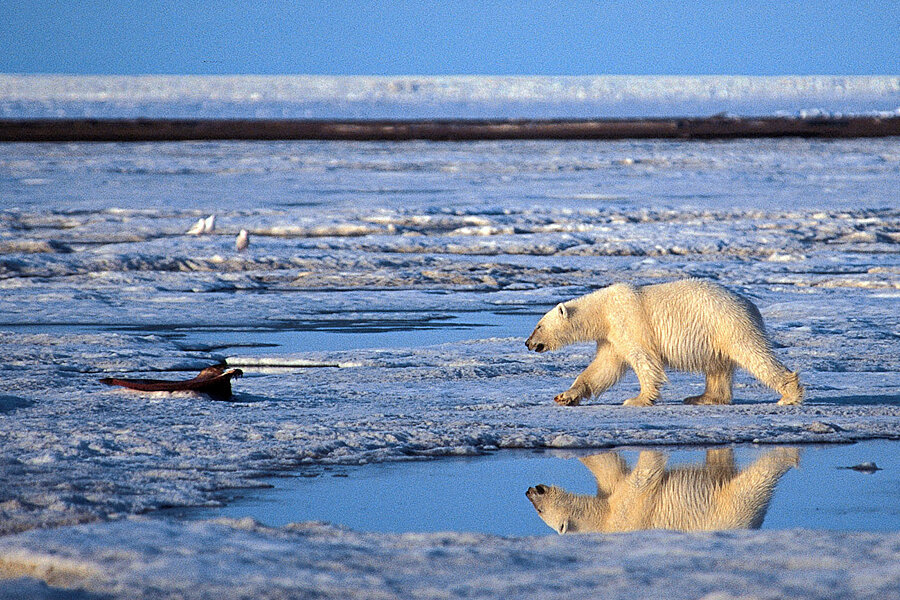Arctic National Wildlife Refuge 101: three questions on where things stand
Loading...
On Sunday, the Obama administration announced that it will propose designating more than 12 million acres in Alaska’s Arctic National Wildlife Refuge (ANWR) – including its coastal plain – as wilderness.
Such a designation – the strongest possible protection for public lands – would fulfill a long-cherished wish on the part of environmental groups, but would anger the energy industry and others who believe the coastal plain should be opened to oil and gas drilling.
The wilderness designation is unlikely to become official with the current congressional makeup. But the move represents a revision to the current management plan, and it's an important symbolic gesture in a debate over the refuge that has been going on for more than three decades. Multiple efforts to drill in ANWR have been shot down over the years, and similar efforts to permanently designate it as wilderness have also not succeeded.
“This is a principled question about whether or not you want to protect an area in perpetuity, or whether or not you want to maintain an option [for drilling] for the future,” says Matthew Kotchen, an economics professor at the Yale School of Forestry in New Haven, Conn. “This is a symbolic issue, for both sides, more than anything else.”
Here are three key questions in the debate.
How important is ANWR environmentally?
According to supporters of the wilderness designation – including most environmental groups as well as indigenous groups in Alaska – it is a unique spot that has vital importance for wildlife and also constitutes one of the last pristine tracts of wilderness in America. In a statement about the wilderness recommendation, Interior Secretary Sally Jewell called it “one of our nation’s crown jewels” and compared it to Yosemite and the Grand Canyon.
It is home to a wide variety of animals, including grizzly bears, musk oxen, and wolves. The coastal plain has particular importance for polar bears and as a calving ground for the Porcupine caribou herd, a herd of 130,000 caribou that migrate 1,500 miles every year, the largest mammal migration on earth.
“It’s as huge and wild as anything imaginable,” says David Hayes, a visiting lecturer at Stanford Law School in California and visiting senior fellow at the Center for American Progress who served as deputy secretary of the Interior under both Presidents Obama and Clinton. “There is not a deficit of opportunity for federal lands and offshore resources in the Arctic. Let’s protect this special place that was set aside as a refuge.”
How important is it as a source for energy exploration?
The debate about drilling has centered on ANWR’s coastal plain, a 1.5 million-acre strip known as the “1002 area.” There’s a great deal of debate about just how much oil exists, though a 1998 US Geological Survey estimate was for between 5.7 billion and 16 billion barrels of technically recoverable oil and gas.
In the past, proponents of opening ANWR to drilling argued that it was vital for national security and energy independence, but with increased production in recent years – particularly around oil shale – that’s less of a concern.
Alaska’s economy has been suffering recently because of low oil prices, and political leaders there have emphasized the economic importance of energy exploration.
In a statement condemning the Obama administration’s proposal, Alaska Sen. Lisa Murkowski (R) was vehement in her anger over the move.
“What’s coming is a stunning attack on our sovereignty and our ability to develop a strong economy that allows us, our children and our grandchildren to thrive,” Senator Murkowski said in her statement. “It’s clear this administration does not care about us, and sees us as nothing but a territory.... I cannot understand why this administration is willing to negotiate with Iran, but not Alaska. But we will not be run over like this. We will fight back with every resource at our disposal.”
Indeed Murkowski, who chairs the Senate Energy and Natural Resources Committee, has promised to retaliate.
Alaska Gov. Bill Walker, an Independent, said the move was akin to telling Hawaii it could no longer have tourism.
Despite the energy industry’s emphasis on the importance of ANWR, however, critics point out that Alaska contains many other oil-rich areas that continue to be open to drilling, particularly in nearby Prudhoe Bay.
“This administration has 30 million acres in [Bureau of Land Management] lands in the Lower 48 open to oil and gas development. They’re doing annual sales in the National Petroleum Reserve just west of Prudhoe Bay," Mr. Hayes says. "There are a lot of reasons for anxiety in Alaska around oil and gas because the price has gone down so much.... But putting the question of oil development writ large as though it stands and falls on whether there are some wells in the coastal plain of the Arctic National Wildlife Refuge – that’s a bridge too far.”
How much would drilling actually affect the refuge?
Again, it depends whom you ask. Drilling techniques have improved significantly in recent decades and have smaller footprints than they used to. Drilling advocates point out that advances in directional drilling would minimize that footprint, and they note that another caribou herd, the central Arctic herd, has managed to coexist and even increase despite drilling and pipeline construction in its calving ground. Thus wildlife can coexist with responsible energy exploration, they say.
“Drill pads don’t take up that much area, and you’re talking about millions and millions of acres. Animals can migrate and walk around these pads,” Professor Kotchen says, though he says there are more questions about the impacts from pipelines.
“Many of the environmental problems could be managed. But I think the symbolic adverse effects are more important than the ones on the ground," he says. "There aren’t a whole lot of those places left, and there are certainly substitutes for places to get the oil and gas.”






